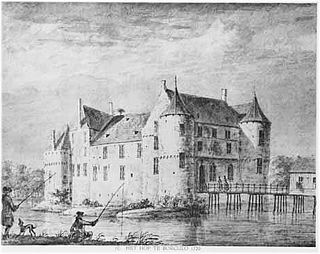
Jobst of Limburg was count of Limburg and Bronckhorst, Lord of Styrum, Wisch and Borculo (1616), and the son of Hermann Georg of Limburg, count of Limburg and Bronckhorst.

Hermann Otto I of Limburg-Styrum, count of Limburg and Bronckhorst, lord of Styrum, Gemen, Wisch and Borculo, and from 1640 to 1644 advocate of the imperial abbey of Vreden, was born in 1592, and died on 17 October 1644. He was the eldest son of Jobst of Limburg Stirum.
Moritz of Limburg Stirum (1633–1664) was the reigning Count of Limburg-Styrum-Styrum.
Gemen was an immediate, sovereign lordship of the Holy Roman Empire, in the Lower Rhine region. Since Gemen had a vote in the Imperial Diet it was also an Imperial Estate. It was centered on Gemen, a small town and castle in the present municipality of Borken, western North Rhine-Westphalia.
Adolf Ernst of Limburg Stirum, count of Limburg Stirum, sovereign lord zu Gemen, son of Hermann Otto I of Limburg-Styrum.

Field Marshal Hermann Otto II of Limburg Stirum, count of Limburg Stirum and Bronckhorst, sovereign lord zu Gemen, was the son of Adolf Ernst of Limburg Stirum and an imperial Field Marshal.

Otto Leopold of Limburg Stirum, count of Limburg Styrum and Bronckhorst, sovereign lord zu Gemen and Raesfeld, was born in 1688 the son of Hermann Otto II of Limburg Stirum.
Friedrich Karl of Limburg Stirum, count of Limburg Styrum and Bronckhorst, sovereign lord of Gemen, son of Otto Leopold of Limburg Stirum, was born in 1710.
Maximilian Wilhelm of Limburg Stirum (1653–1728), count of Limburg Styrum, sovereign lord of Illereichen and Simontornya. He was the third son of Adolf Ernst of Limburg Stirum, sovereign lord zu Gemen.
Ferdinand Gotthard Meinrad of Limburg Stirum, count of Limburg, "Fürst" von Styrum, sovereign lord zu Gemen, was born in 1701, son of Maximilian Wilhelm of Limburg Stirum.
Karl Joseph Alois of Limburg Stirum, count of Limburg Stirum from the branch Limburg-Styrum-Iller-Aichheim, was the son of Maximilian Wilhelm of Limburg Stirum. He was born in 1685 and died in 1738. After his father's death he became sovereign lord of Simontornya.
Karl Josef Maximilian of Limburg Stirum, count of Limburg Styrum, sovereign lord zu Gemen, was the son of Alois of Limburg Stirum.
Johann Nepomuck of Limburg Stirum, count of Limburg Styrum, sovereign lord zu Gemen, son of Alois of Limburg Stirum, was born in 1756. He married in 1784 Maria Walpurga vom Stain and they had issue:

Ferdinand IV August Carl Joseph Johannes Nepomuk Thaddeus, Count of Limburg-Stirum zu Illereichen, was sovereign lord of the immediate lordship of Gemen.

The House of Limburg-Stirum, which adopted its name in the 12th century from the immediate county of Limburg an der Lenne in what is now Germany, is one of the oldest families in Europe. It is the eldest and only surviving branch of the House of Berg, which was among the most powerful dynasties in the region of the lower Rhine during the Middle Ages. Some historians link them to an even older dynasty, the Ezzonen, going back to the 9th century.
Limburg-Styrum-Gemen was a county of medieval Germany, based in the Lordship of Gemen in modern North Rhine-Westphalia. It was partitioned from Limburg-Styrum in 1644, and in 1657 partitioned into itself and Limburg-Styrum-Iller-Aichheim. As Limburg-Styrum-Gemen ruled an Imperial Estate (Gemen), the Counts had a seat on the Bench of Counts of Westphalia. The line of Counts became extinct in 1782 and was inherited by the Counts of Limburg-Styrum-Iller-Aichheim.
Limburg-Styrum-Styrum was a County of medieval Germany, based in the Lordship of Styrum in modern North Rhine-Westphalia. Limburg-Styrum-Styrum was a partition of Limburg-Styrum in 1644. When the line of Limburg-Styrum-Iller-Aichheim became extinct in 1800, Limburg-Styrum-Styrum failed to inherit it and the Imperial Estate of Gemen, which instead passed to the Barons of Boyneburg-Bömelberg. In 1806 Limburg-Styrum-Styrum was mediatised to the Grand Duchy of Berg. The line itself became extinct in 1809.
Leopold Johann Otto Wilhelm of Limburg Stirum, was count of Limburg Styrum from the branch Limburg-Styrum-Iller-Aichheim.
Philipp Ferdinand von Limburg Stirum, Count of Limburg, lord of Styrum, was the fourth reigning count from the branch Limburg-Styrum-Styrum. He was also heir of Wilhermsdorf in Franconia and of the sovereign Lordship of Oberstein.
Jobst Hermann von Holstein-Schaumburg was a member of the House of Schaumburg.